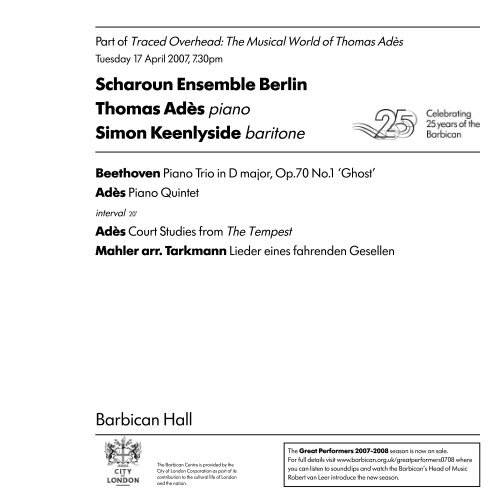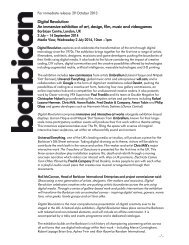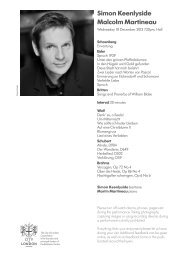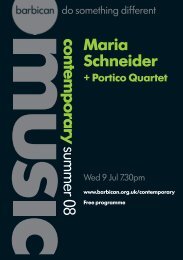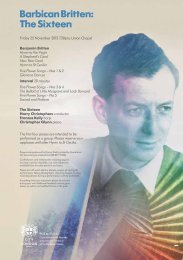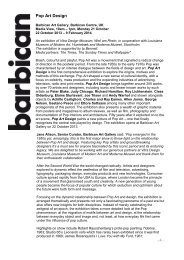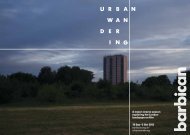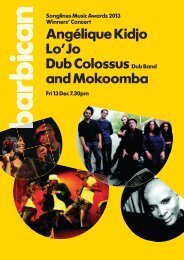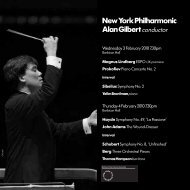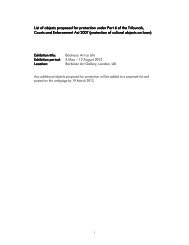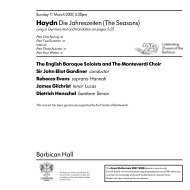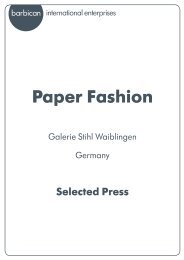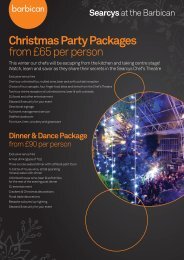Barbican Hall Scharoun Ensemble Berlin Thomas Adès piano ...
Barbican Hall Scharoun Ensemble Berlin Thomas Adès piano ...
Barbican Hall Scharoun Ensemble Berlin Thomas Adès piano ...
You also want an ePaper? Increase the reach of your titles
YUMPU automatically turns print PDFs into web optimized ePapers that Google loves.
Part of Traced Overhead: The Musical World of <strong>Thomas</strong> Adès<br />
Tuesday 17 April 2007, 7.30pm<br />
<strong>Scharoun</strong> <strong>Ensemble</strong> <strong>Berlin</strong><br />
<strong>Thomas</strong> Adès <strong>piano</strong><br />
Simon Keenlyside baritone<br />
Beethoven Piano Trio in D major, Op.70 No.1 ‘Ghost’<br />
Adès Piano Quintet<br />
interval 20’<br />
Adès Court Studies from The Tempest<br />
Mahler arr. Tarkmann Lieder eines fahrenden Gesellen<br />
<strong>Barbican</strong> <strong>Hall</strong><br />
The <strong>Barbican</strong> Centre is provided by the<br />
City of London Corporation as part of its<br />
contribution to the cultural life of London<br />
and the nation.<br />
The Great Performers 2007-2008 season is now on sale.<br />
For full details visit www.barbican.org.uk/greatperformers0708 where<br />
you can listen to soundclips and watch the <strong>Barbican</strong>’s Head of Music<br />
Robert van Leer introduce the new season.
Ludwig van Beethoven (1770-1827)<br />
Piano Trio in D major, Op.70 No.1 ‘Ghost’<br />
I. Allegro vivace e con brio<br />
II. Largo assai ed espressivo<br />
III. Presto<br />
The <strong>piano</strong> trio was a useful genre for a musician who<br />
was making a name for himself as both pianist and<br />
composer among the Viennese aristocracy, and<br />
Beethoven published a set of three such works as his<br />
Op.1, in 1795. Two years later came his trio with clarinet.<br />
By the time he returned to the straight <strong>piano</strong>-violin-cello<br />
trio, more than a decade further on, he was very much<br />
more a composer than a pianist, and this is reflected in<br />
the texture, scale and weight of the three trios that<br />
resulted: the pair of Op.70 and the singleton ‘Archduke’.<br />
The ‘Ghost’ Trio owes its name to its slow movement, in D<br />
minor, and to a remark by Beethoven’s pupil Carl Czerny,<br />
that ‘it resembles an appearance from the Underworld.<br />
One could think not inappropriately of the first<br />
appearance of the ghost in Hamlet.’ If this was a guess, it<br />
was a good one. While working on the trio, in 1808,<br />
Beethoven was also making sketches for an opera to be<br />
based on one of Shakespeare’s plays – not Hamlet, in<br />
<strong>Thomas</strong> Adès (b. 1971)<br />
Piano Quintet, Op.20<br />
Writing in 2000 for the following year’s Melbourne<br />
Festival, Adès may have wanted to start the new<br />
millennium afresh. Here for the first time in his output was<br />
an instrumental work of long continuity, a work that,<br />
Notes<br />
Beethoven<br />
fact, but one that also has a ghost in it: Macbeth. The<br />
savage discords and the tremolandos are plausible<br />
manifestations of the Gothic style, especially when<br />
combined with a degree of thematic repetition that could<br />
be heard as obsessive or possessed. Perhaps, too,<br />
Czerny’s attention was caught by those moments where<br />
the pianist’s left hand stalks the bass (‘A figure like your<br />
father,’ as Horatio tells Hamlet, ‘with solemn march goes<br />
slow and stately by’).<br />
No less remarkable is the first movement, whose stern<br />
opening gesture seems to impel everything that follows –<br />
not as an idea to be imitated but more as one to be<br />
avoided. From one extreme here the music goes at once<br />
to another: from short ejaculation to legato phrase, from<br />
clattering tutti to solo, from <strong>piano</strong>-dominated texture to<br />
strings, from loud to soft. But that initial challenge won’t,<br />
can’t be forgotten. The finale is, as so often in<br />
Beethoven’s chamber music, a rondo with development.<br />
Adès<br />
though it includes a full repetition of one big section,<br />
moves masterfully forward through a span of 20 minutes<br />
(sometimes on two or more fronts at once), and<br />
generates so much momentum, such a richness of<br />
3
Notes<br />
possibility, that its ending seems brutally abrupt as well<br />
as necessary.<br />
The scheme looks absurdly conventional. An introduction,<br />
for the first violin alone, is followed by the textbook<br />
phases of a sonata form: exposition (repeated, as it was<br />
classically), development and recapitulation. But the<br />
music is not made in a textbook way at all. The basic<br />
ideas are very compact. It is perhaps no surprise that they<br />
should be so malleable, for little things have many ways<br />
to change, but it is astonishing that they should remain,<br />
through all their changes, so memorable. The<br />
introduction, for instance, is made of two tiny elements<br />
that keep their characters even though they are right<br />
away interfering with one another: a rise in broken chords<br />
and a falling scale fragment. In their dialogues and<br />
interpenetrations they create what might be called the<br />
main theme, but, being constituted of transformation, this<br />
theme cannot keep still. Perhaps Bartók was the<br />
inspiration for a sonata form built by musical corpuscles<br />
in constant action – though the music does not sound like<br />
Bartók at all. It sounds like Adès, and not least when,<br />
towards the end of the five-minute exposition, the material<br />
makes the poignant discovery within itself of a simple<br />
tune, like a children’s song, or a remembered hymn.<br />
4<br />
Pressure for all this change comes partly from the<br />
harmony, but the Quintet is also a vigorously rhythmic<br />
piece, where again everything comes from<br />
fundamentals. A lot is done with the iambic pattern,<br />
unstressed-stressed. From this comes a maze of unusual<br />
metres, often with the <strong>piano</strong> and the strings in conflict<br />
with one another, musical tugs of war. But the strong<br />
beats are always strongly present for the music to be<br />
thrown against.<br />
The ‘development section’ is initiated by the <strong>piano</strong> with<br />
an upside-down version of the main theme: chords<br />
falling, rising scales. Soon there is turmoil, harmonic and<br />
rhythmic, with all five players in their own metrical<br />
frames, always altering and sometimes interlocking. Out<br />
of this comes a long slow section, with the <strong>piano</strong> only<br />
intermittently present.<br />
Then the first violin goes back to the broken chords that<br />
got the whole thing going, only to find them a little<br />
different and to be played pizzicato. Everything else is<br />
more than a little different, and there is a prevailing urge<br />
to finish, to make this not so much recapitulation as coda.<br />
<strong>Thomas</strong> Adès<br />
Court Studies from The Tempest<br />
I. The False Duke – II. The Prince – III. The King – IV. The False Duke’s Defeat – V. The Counsellor – VI. The King’s Grief<br />
Written in 2005, the year after the first performance of<br />
Adès’s operatic treatment of The Tempest, this eightminute<br />
movement for clarinet, violin, cello and <strong>piano</strong><br />
scans the leading figures who arrive on Prospero’s<br />
island: the usurper Antonio, Ferdinand and his father, the<br />
King of Naples, and the honest old counsellor Gonzalo.<br />
Here they are, compressed into designs as crisp and<br />
stylised as on a hand of (court) cards. Antonio is figured<br />
interval 20’<br />
first in a slippery dance, then in a sneaking one;<br />
Ferdinand’s music is alternately assertive and sweet; the<br />
King’s a drooping shadowplay between two lines. A<br />
shock fanfare introduces them, intervenes again before<br />
Gonzalo’s amiable portrait, and, greatly decelerated,<br />
provides the material for the quasi-passacaglia with<br />
which the work ends.
Gustav Mahler (1860-1911)<br />
arr. Andreas N. Tarkmann (b. 1956)<br />
Lieder eines fahrenden Gesellen<br />
I. Wenn mein Schatz Hochzeit macht<br />
II. Ging heut’ Morgen über’s Feld<br />
III. Ich hab’ ein glühend Messer<br />
IV. Die zwei blauen Augen von meinem Schatz<br />
Mahler’s Lieder eines fahrenden Gesellen (‘Songs of a<br />
Wayfarer’) travel through many dimensions of time. They<br />
had a travelling growth, begun in the mid-1880s as songs<br />
with <strong>piano</strong> but not definitively completed until shortly<br />
before the first performance, which was of the<br />
composer’s orchestrated version, in <strong>Berlin</strong> in 1896. They<br />
thus travelled with Mahler from the threshold of his First<br />
Symphony (to which the second song is related) up to the<br />
time when he was finishing his Third, and the texts, which<br />
he wrote himself, are close to the folk poetry that was on<br />
his mind at the time – especially the early 19th-century<br />
collection Des Knaben Wunderhorn (‘The Boy’s Magic<br />
Horn’). The settings, too, hark back to that same early<br />
Romantic period, and in particular to Schubert’s<br />
I.<br />
Wenn mein Schatz Hochzeit macht,<br />
Fröhliche Hochzeit macht,<br />
Hab’ ich meinen traurigen Tag!<br />
Geh’ ich in mein Kämmerlein,<br />
Dunkles Kämmerlein!<br />
Weine! Wein’! Um meinen Schatz,<br />
Un meinen lieben Schatz!<br />
Blümlein blau! Blümlein blau!<br />
Verdorre nicht, verdorre nicht!<br />
Vöglein süss! Vöglein süss!<br />
Du singst auf grüner Heide!<br />
‘Ach! wie ist die Welt so schön!<br />
Ziküth! Ziküth!’<br />
Notes<br />
Mahler<br />
Winterreise (‘Winter Journey’). Here again is a traveller<br />
singing out his hopes and (even more) his anxieties, and<br />
finding them mirrored in the world around him as he<br />
passes. The songs also travel harmonically, from key to<br />
key. And they go on travelling in this arrangement.<br />
A version with 10 players was created in 1919 for<br />
Schoenberg’s Society for Private Musical Performances.<br />
Tonight’s adaptation was made by the prolific German<br />
arranger Andreas N. Tarkmann in 1998, and deepens<br />
the music’s Schubertian tinge by setting the<br />
accompaniment out for the line-up of the earlier<br />
composer’s Octet: strings with clarinet, horn and<br />
bassoon.<br />
I.<br />
When my sweetheart has her wedding,<br />
happy wedding,<br />
that’s for me a rotten day.<br />
Take myself, I do, to my little room,<br />
dark little room,<br />
and weep, weep for my girl,<br />
my lovely girl!<br />
Little flower of blue! Of blue!<br />
Do not fade! Do not fade!<br />
Sweet bird! Sweet bird!<br />
Who sings on the green heath!<br />
‘Oh, how beautiful the world is!<br />
Ta-ra! Ta-ra!’<br />
please turn page quietly …<br />
5
Notes<br />
Singet nicht! Blühet nicht!<br />
Lenz ist ja vorbei!<br />
Alles Singen ist nun aus!<br />
Des Abends, wenn ich schlafen geh’,<br />
Denk’ ich an mein Leide!<br />
An mein Leide!<br />
II.<br />
Ging heut’ Morgen über’s Feld,<br />
Tau noch auf den Gräsern hing,<br />
Sprach zu mir der lüst’ge Fink:<br />
‘Ei, du! Gelt?<br />
Guten Morgen! Ei, Gelt? Du!<br />
Wird’s nicht eine schöne Welt?<br />
Zink! Zink! Schön und flink!<br />
Wie mir doch die Welt gefällt!’<br />
Auch die Glockenblum’ am Feld<br />
Hat mir lustig guter Ding’,<br />
Mit den Glöckchen, klinge, kling,<br />
Ihren Morgengruss geschellt:<br />
‘Wird’s nicht eine schöne Welt?<br />
Kling! Kling! Schönes Ding!<br />
Wie mir doch die Welt gefällt!’<br />
Und da fing im Sonnenschein<br />
Gleich die Welt zu funkeln an:<br />
Alles, Ton und Farbe gewann!<br />
Im Sonnenschein!<br />
Blum’ und Vogel, gross und klein!<br />
‘Guten Tag! Guten Tag!<br />
Ist’s nicht eine schöne Welt?<br />
Ei, du! Gelt? Schöne Welt!’<br />
Nun fängt auch mein Glück wohl an?!<br />
Nein! Nein! Das ich mein’,<br />
Mir nimmer blühen kann!<br />
III.<br />
Ich hab’ ein glühend Messer,<br />
Ein Messer in meiner Brust.<br />
O weh! O weh!<br />
Das scheid’t so tief<br />
In jede Freud’ und jede Lust,<br />
So tief! So tief!<br />
Es schneid’t so weh und tief!<br />
6<br />
Do not sing! Do not bloom!<br />
Spring’s already gone!<br />
No more singing can there be!<br />
Evenings, when I go to sleep,<br />
I think over my sorrows!<br />
My sorrows!<br />
II.<br />
Went this morning o’er the field,<br />
dew still hanging on the leaves;<br />
spoke to me a cheerful bird:<br />
‘Hey, you! OK?<br />
Good morning! Hey, you!<br />
Isn’t this a lovely world?<br />
Cheep! Cheep! Fair and bright!<br />
Just like me the world’s so pleased!’<br />
And the bluebells were in flower,<br />
struck me as a funny thing,<br />
little bells a-ringing, ring,<br />
ringing with their morning call:<br />
‘Isn’t this a lovely world?<br />
Ting! Ting! Lovely thing!<br />
Just like me the world’s so pleased!’<br />
And beneath the shining sun<br />
All the world began to glow:<br />
All with colour and with sound,<br />
The shining sun!<br />
Flower and bird, big and small,<br />
‘Good day to you, good day to you!<br />
Isn’t this a lovely world?<br />
Hey, you! OK?’<br />
Now at last will my luck come in?<br />
No, no, that I know,<br />
that will never bloom for me!<br />
III.<br />
I have a glowing dagger,<br />
a dagger in my breast.<br />
Alas! Alas!<br />
It cuts so deep<br />
In ev’ry joy, in ev’ry hope,<br />
so deep, so deep!<br />
It cuts so sharp and deep!
Ach, was ist das für ein böser Gast!<br />
Nimmer hält er Ruh’,<br />
Nimmer hält er Rast!<br />
Nicht bei Tag,<br />
Nicht bei Nacht, wenn ich schlief!<br />
O weh! O weh! O weh!<br />
Wenn ich in den Himmel seh’,<br />
Seh’ ich zwei blaue Augen steh’n!<br />
O weh! O weh!<br />
Wenn ich im gelben Felde geh’,<br />
Seh’ ich von fern das blonde Haar<br />
Im Winde weh’n! O weh! O weh!<br />
Wenn ich aus dem Traum auffahr’<br />
Und höre klingen ihr silbern Lachen,<br />
O weh! O weh!<br />
Ich wollt’ ich läg’ auf der schwarzen Bahr’,<br />
Könnt’ nimmer, nimmer die Augen aufmachen!<br />
IV.<br />
Die zwei blauen Augen von meinem Schatz,<br />
Die haben mich in die weite Welt geschickt.<br />
Da musst’ ich Abschied nehmen<br />
Vom allerliebsten Platz!<br />
O Augen blau, warum habt ihr mich angeblickt?<br />
Nun hab’ ich ewig Leid und Grämen!<br />
Ich bin ausgegangen in stiller Nacht,<br />
Wohl über die dunkle Heide.<br />
Hat mir niemand Ade gesagt, Ade!<br />
Mein Gesell’ war Lieb’ und Leide!<br />
Auf der Strasse steht ein Lindenbaum,<br />
Da hab’ ich zum ersten Mal im Schlaf geruht!<br />
Unter dem Lindenbaum!<br />
Der hat seine Blühen über mich geschneit<br />
Da wusst’ ich nicht, wie das Leben tut<br />
War Alles, alles wieder gut!<br />
Alles! Alles!<br />
Lieb’ und Leid, und Welt, und Traum!<br />
Ah, such a fearful guest to have,<br />
Never letting up,<br />
never letting rest!<br />
Not by day,<br />
not by night, when I sleep!<br />
Alas! Alas! Alas!<br />
When I look up to the sky,<br />
there I see two eyes of blue.<br />
Alas! Alas!<br />
When I go into the golden fields,<br />
I see from afar, waving,<br />
blonde hair in the wind. Alas! Alas!<br />
When I rise up in my dreams<br />
And hear her silver laugh,<br />
Alas! Alas!<br />
I wish I lay on a coal-black bier,<br />
and never could open my eyes more!<br />
IV.<br />
The two blue eyes of my darling girl<br />
have sent me out to travel the world.<br />
So I must say goodbye<br />
to the place I love best of all!<br />
O eyes of blue, why did you look at me?<br />
Sorrows and griefs are now my lot.<br />
I’m going out into the peaceful night,<br />
over the darkening heath.<br />
Nobody’s said to me: Goodbye!<br />
My companion was my love and sorrow!<br />
By the road stood a lime tree,<br />
where for the first time I slept in peace.<br />
Under the lime tree,<br />
which snowed on me its flowers,<br />
I forgot what life does,<br />
and everything, everything was good again!<br />
Everything! Everything!<br />
Love and sorrow, and world and dream!<br />
Translation: Paul Griffiths © 2007<br />
Notes<br />
Programme notes by Paul Griffiths © 2007<br />
7
About the performers<br />
Tracing <strong>Thomas</strong> Adès<br />
To begin at the beginning, or at the beginnings, a lot of<br />
<strong>Thomas</strong> Adès’s works start out with some tiny corpuscle<br />
of sound that is repeated, and repeated again, and<br />
repeated again, but already it is changing. Through the<br />
repetitions a process is being set up, and there may well<br />
be something in the bass steering that process. The<br />
shape is recognisably the same, but it is mutating all the<br />
time, and it is going somewhere. It might be as simple a<br />
thing as a fall from one note to another, or a rising bit of<br />
scale, or a bar of dance rhythm. But the process, which<br />
started right away, will have made it seem instantly fresh,<br />
magical, a new beginning.<br />
How does he do it? Harmony is the key: harmony that is<br />
‘neither atonal nor tonal’, as György Ligeti said of his<br />
own, or, perhaps more exactly, harmony that knows<br />
other tonal rules than those of the old keys – though it<br />
certainly knows those rules too, and plays with them.<br />
Ligeti is also one point of reference for Adès’s rhythm,<br />
which is at once elaborate and ramshackle, precisionengineered<br />
and on the point of collapse – collapse into<br />
confusion or into the daemonic pulsation that will often<br />
arrive in his music from somewhere else: the dance floor.<br />
Other sources for Adès’s harmony would have to include<br />
the French Spectralist composers, with their shimmering<br />
sonorities modelled on the overtone spectra of sounds –<br />
though Adès has been unusually bold and original in<br />
recognising how spectra could be trimmed to deliver,<br />
hey presto, common chords, complete with possibilities<br />
of new life instilled in them. To the Spectralists, Ligeti and<br />
Popstarz one could add other forebears, of whom some<br />
are assembled around Adès’s music in this series:<br />
Sibelius and Nancarrow, Stravinsky and Kurtág,<br />
Schumann and Janác˘ek.<br />
8<br />
Adès<br />
Manifest as all these reflections will be, what is strange<br />
and wonderful is the freedom from irony. As with the<br />
small elements from which his music is made, so it is with<br />
things borrowed that their reuse refreshes them. A grand<br />
harmonic veer may signal Sibelius, but there is none of<br />
the old 20th-century’s bother about this sort of reference.<br />
Echoes from the past are proving the habitability of a<br />
new world.<br />
Assailing that world – tracing its continents that float<br />
overhead and glisten in so many harmonic lights – is<br />
easier for the ears than for words. Adès’s music holds out<br />
an old promise that has widely been withdrawn (one<br />
understands the attraction Ligeti and Kurtág hold for<br />
him), of being fathomable. It not only attracts but conveys<br />
us, even if into curved spaces and down wonky<br />
perspectives, and convinces us that eventually it will be<br />
lucid to its ultimate recesses.<br />
Sounding on from the past here are not only traits from<br />
earlier composers but ancient ideas suddenly<br />
replenished and brimming: theme, development, a tune<br />
as simple as a nursery rhyme but never heard before, a<br />
chord progression that moves powerfully forward in a<br />
quite new direction. As the private jokes and allusions of<br />
his earlier pieces have fallen away – things that helped<br />
make those pieces at once entrancing and maddening –<br />
so the music has become clearer without losing its<br />
ambiguity, which now depends on a richness of<br />
meanings infolded but no longer encrypted.<br />
Always scintillating and at once enthralling, Adès’s music<br />
has come to yield more and more on repeated listening,<br />
and one wonders to what extent his confidence that this<br />
could happen was bolstered by the immediacy with<br />
which his works were recorded when he was still in his
twenties. What was criticised at the time as hype, and<br />
potentially dangerous for an artist so young, may in fact<br />
have speeded up his growth.<br />
Doubtless there will be further change, in ways<br />
unforeseeable. But Adès, at 36, is already the consistent<br />
master of a style that is – despite the echoes and<br />
reflections, which in any case are probably never quite<br />
what they seem – identifiable and unique. He has a<br />
genius for the big miniature – the piece that lasts just a<br />
few minutes, within which it thoroughly explores some<br />
new sound combination or compositional tactic, or else<br />
tackles an old one in a new way. Many of his pieces from<br />
the Nineties are of this kind, whether self-standing or<br />
contained within larger works (Powder Her Face, which<br />
was his first opera, or Asyla, effectively his first<br />
symphony). But he has always had a sure command, too,<br />
of larger forms, continuous and capacious, and<br />
beguilingly persuasive.<br />
Even so, what may be his most valuable characteristic,<br />
and certainly his rarest, is that he can bring candour into<br />
a context of sophistication. The assurance that allows him<br />
to hold musical conversation with eminent composers<br />
two or three generations older, to programme his music,<br />
as he does here, with the marbled great, and to<br />
anticipate an audience that will want to come to his music<br />
again and again, that assurance, it may be, is what gives<br />
him access to the very frankest kinds of musical<br />
expression. Few other composers of today could have<br />
exited today’s cynicism sufficiently to produce a fullblown<br />
love duet, as Adès does in his second opera, The<br />
Tempest. Few could conjure, or appropriately stage, the<br />
kind of naked melody that is cropping up more and more<br />
in Adès’s music, even as that music deepens.<br />
Simplicity in our time is the hardest thing to achieve. Here<br />
in Adès’s music it is happening, time and again.<br />
Paul Griffiths © 2007<br />
For more information visit<br />
www.barbican.org.uk/tracedoverhead or<br />
www.fabermusic.com<br />
About the performers<br />
<strong>Thomas</strong> Adès <strong>piano</strong><br />
Born in London, where he lives,<br />
<strong>Thomas</strong> Adès studied <strong>piano</strong> at<br />
the Guildhall School of Music &<br />
Drama, and read music at King’s<br />
College, Cambridge. Among his<br />
best known works are Living<br />
Toys, Arcadiana, and Asyla – a<br />
commission for Sir Simon Rattle<br />
and the CBSO (1997) which enjoyed immediate and<br />
subsequent international succcess. Tevot, his latest<br />
orchestral work, features as part of the <strong>Berlin</strong>er<br />
Philharmoniker’s current tour.<br />
Adès’s first opera, Powder Her Face, has been performed<br />
around the world, televised and recorded. Most of the<br />
composer’s music has been recorded by EMI, with whom<br />
Adès has a contract as composer, pianist and conductor.<br />
His second opera, The Tempest, was commissioned by<br />
the Royal Opera House, Covent Garden, and was<br />
premiered there under the baton of the composer in<br />
2004; it was revived at Covent Garden last month.<br />
In demand worldwide as a conductor and pianist, Adès is<br />
a renowned interpreter of his own music, while his<br />
performances and recordings of other composers have<br />
also been critically acclaimed. His chamber music<br />
collaborators include Ian Bostridge and the Belcea<br />
Quartet and he has conducted many orchestras and<br />
ensembles including Birmingham Contemporary Music<br />
Group, with which he has a close association. He has been<br />
Artistic Director of the Aldeburgh Festival since 1999. He is<br />
the featured composer this spring in the Présences Festival<br />
in Paris, where 23 of his works are being programmed and<br />
broadcast in just under a month, in performances involving<br />
over 700 musicians. Later this year Adès is the focus of<br />
Oslo’s Ultima Festival, and in 2007/08 he undertakes a<br />
major residency at Carnegie <strong>Hall</strong>, New York.<br />
The music of <strong>Thomas</strong> Adès has attracted wide<br />
international recognition including, most recently, the<br />
2000 Grawemeyer Award for Asyla (the largest<br />
international prize for composition, here awarded to the<br />
youngest recipient), the 2001 Hindemith Prize, and a<br />
2005 Royal Philharmonic Society Award for The Tempest.<br />
9
About the performers<br />
Simon Keenlyside baritone<br />
Simon Keenlyside was born in<br />
London, studied zoology at<br />
Cambridge and singing with John<br />
Cameron at the Royal Northern<br />
College of Music in Manchester.<br />
He has sung Pelléas (San<br />
Francisco, Geneva, Madrid, New<br />
York, Paris, Salzburg); Mozart’s<br />
Count Almaviva (Teatro alla Scala,<br />
Milan, Royal Opera House, Covent Garden, Vienna,<br />
Munich); Papageno (Scottish Opera, Paris, La Scala,<br />
Metropolitan Opera, New York, Salzburg Festival, Royal<br />
Opera, Vienna); Hamlet (Geneva, Royal Opera,<br />
Barcelona); Marcello (Vienna, Munich, Royal Opera,<br />
Metropolitan Opera); Wolfram (Munich and Tokyo);<br />
Monteverdi’s Orfeo (Brussels); Billy Budd (Royal Opera,<br />
English National Opera, Vienna); Don Giovanni<br />
(Brussels, Ferrara, Zurich, Royal Opera, Vienna, Munich<br />
and Tokyo); and Posa (Madrid, Munich and Vienna).<br />
He sang Prospero in the premiere and recent revival of<br />
<strong>Thomas</strong> Adès’s The Tempest and in the premiere of<br />
Lorin Maazel’s 1984, both under the composer (Royal<br />
Opera House). He will return to the Vienna State Opera<br />
(Eugene Onegin); Munich (Wolfram, Count Almaviva,<br />
Posa); Metropolitan Opera (Count Almaviva); Barcelona<br />
(Don Giovanni); and the Royal Opera House (Pelléas,<br />
Posa, Papageno and Oreste).<br />
Concert engagements have taken him to many leading<br />
orchestras while he has appeared in recital the world<br />
over, including at the major festivals. Recordings have<br />
included the roles of Papageno with Sir Charles<br />
Mackerras, Count Almaviva with René Jacobs, Don<br />
Giovanni with Claudio Abbado, Billy Budd with Richard<br />
Hickox, Marcello with Riccardo Chailly, as well as Des<br />
Knaben Wunderhorn with Sir Simon Rattle and recital<br />
discs of Schubert, Schumann and Strauss with Malcolm<br />
Martineau and Graham Johnson. He is now an exclusive<br />
recording artist for Sony BMG. In 2006 Simon Keenlyside<br />
won the Olivier Award for Outstanding Achievement in<br />
Opera.<br />
10<br />
<strong>Scharoun</strong> <strong>Ensemble</strong> <strong>Berlin</strong><br />
The <strong>Scharoun</strong> <strong>Ensemble</strong> <strong>Berlin</strong> was founded in 1983 by<br />
members of the <strong>Berlin</strong>er Philharmoniker. From its very<br />
first concert – featuring Schubert’s Octet – the ensemble<br />
attracted critical acclaim. It takes its name from the<br />
German architect, Hans <strong>Scharoun</strong>, associated with his<br />
greatest creation, the <strong>Berlin</strong> Philharmonie, home of the<br />
<strong>Berlin</strong>er Philharmoniker. Setting new standards worldwide,<br />
the hall contained space for making music in the<br />
spirit of conveying tradition and innovation, increasing<br />
communication and developing understanding. The<br />
musicians continue to explore <strong>Scharoun</strong>’s legacy in their<br />
artistic commitment to the rich heritage of music of the<br />
past as well as meeting the challenges of the present and<br />
preparing for the future. The ensemble uses the classic<br />
octet instrumentation as its basis: clarinet, horn, bassoon,<br />
two violins, viola, cello and double bass. Schubert’s<br />
Octet, Beethoven’s Septet and masterpieces by Mozart<br />
and Brahms form the core of its Classical-Romantic<br />
repertoire. Programmes often include works with<br />
additional members of the <strong>Berlin</strong>er Philharmoniker, as<br />
well as involving a range of international conductors and<br />
soloists. In recent years, <strong>Scharoun</strong> <strong>Ensemble</strong> concerts<br />
have been conducted by Claudio Abbado, Daniel<br />
Barenboim and Simon Rattle amongst others. Alongside<br />
Classical and Romantic repertoire, the <strong>Scharoun</strong><br />
<strong>Ensemble</strong> <strong>Berlin</strong> includes works for less usual<br />
combinations of instruments. Contemporary music<br />
(including many commissions) makes up a significant<br />
part of the ensemble’s programming, including works by<br />
Henze, Kurtág, Ligeti, Reimann, Stockhausen, Yun and,
of course, Adès. The ensemble undertakes frequent<br />
concert tours and gives regular performances at major<br />
international music festivals such as <strong>Berlin</strong>, Salzburg<br />
Easter, Lucerne and Edinburgh and has established itself<br />
as one of the most prominent chamber music ensembles<br />
in Europe.<br />
Alexander Bader clarinet<br />
Markus Weidmann bassoon<br />
Stefan de Leval Jezierski horn<br />
Wolfram Brandl violin<br />
Christoph Streuli violin<br />
Micha Afkam viola<br />
Richard Duven cello<br />
Peter Riegelbauer double bass<br />
About the performers<br />
Find out first Why not download your Great Performers programme before the concert? Each programme is now available online five days in advance of each<br />
concert. Due to the possibility of last minute changes, the online programme content may differ slightly from that of the final printed version. For details visit<br />
www.barbican.org.uk/greatperformers<br />
Please make sure that all digital watch alarms and mobile phones are switched off during the performance. In accordance with the requirements of the licensing<br />
authority, sitting or standing in any gangway is not permitted. No smoking, eating or drinking is allowed in the auditorium. No cameras, tape recorders or any other<br />
recording equipment may be taken into the hall.<br />
Programme edited by Edge-Wise, artwork by Jane Denton; printed by Vitesse London; advertising by Cabbell (tel. 020 8971 8450)<br />
11


